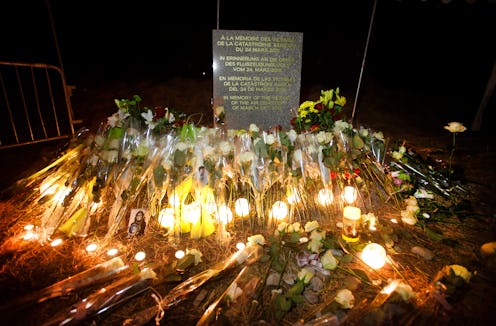News
Real Or Not, Germanwings Video Should Be Private
Investigations into last week's Germanwings Flight 9525 crash are still deep underway, but the latest discovery might have caused more controversy than officials expected. On Tuesday, the German paper Bild and French publication Paris Match claimed that they had obtained mobile phone footage of the final few moments inside the Airbus A320 crash that slammed into the French Alps on March 24, killing all on board. By midday, CNN had reported that French investigators on the recovery effort were contradicting the paper's claims, insisting that while teams had discovered multiple camera phones, reports of leaked footage were "completely wrong." Regardless of whether the alleged footage was real or not, releasing any video of the Germanwings crash to the public would likely be an unapologetic and callous move.
On Tuesday morning, Paris Match reported that it had received the cell phone footage from an unknown "source close to the investigation," though the magazine did not speculate any further. In the video, they alleged that the "chaotic scene" made it "hard to identify people," but that passengers were screaming in several languages. The report also stated that the video captured the sounds of metallic banging and heavy shaking before the footage cut out.
By Tuesday afternoon, however, crash investigators had come forward to discredit both publications' supposed video leak. Marseille Prosecutor Brice Robin denied that investigators had found any such video, reported CBS and the AP; French Gendarmerie spokesman Lt. Col. Jean-Marc Menichini told CNN that both reports were completely "unwarranted." But whether the video itself was a hoax or the real deal was beyond the point.
Whenever natural disasters, terrifying accidents, or gruesome attacks occur in collaboration with video footage, it's tempting to want to watch. Experts have even explained that it might be completely natural to not want to look away. In a 2013 radio interview with NPR's Here & Now, however, Eric Wilson (author of Everyone Loves A Good Train Wreck: Why We Can’t Look Away) describes our natural human instinct to keep looking even when we know we probably shouldn't:
On a very basic level, when we witness violence, destruction, we have a physiological rush. Our heart rate goes up. We release hormones. But I think, also, there's psychological draws to macabre experiences. I think there's a feeling of we're looking at something we should not see and there's a titillation to the taboo. We feel bad for looking at it, but, yet, we get a rush because we can look at it.
... I think it's up to the viewers to choose how often we watch these videos, and ultimately figure out why we're watching these videos. If we're doing it for a cheap thrill, obviously, we should question ourselves.
After the release of the recent slew of ISIS beheading videos, many felt that the media in particular had crossed a line when considering airing the final moments of a human life. In a September 2014 interview, following the graphic beheadings of ISIS captives and American journalists, Steven Sotloff and James Foley, Huffington Post Executive Religion Editor Rev. Paul Raushenbush explained:
I want to know about the life of the person who died, the life of the person who was taken from us, who actually was so brave and [was] motivated by deep humanitarian care, and I learn about them. I don’t need to see it to know it’s brutal, but I do feel like my duty, my emotional allegiance, is actually to the people who have just died.
In the case of the new purported Germanwings cell footage, the general sentiment is hesitant at best, as it probably should be. After all, each time video evidence is dragged before the public it tends to either dull the reactions of those who experienced it secondhand — or re-opens the wounds of the loved ones who likely never wanted to see it in the first place.
Images: Getty Images (2)
